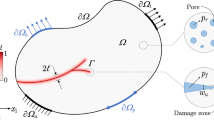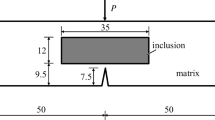Abstract
The finite cover method (FCM), which is a cover-based generalized finite element method, is extended for analyses of progressive failure processes involving cohesive zone fracture, starting from an interface debonding and evolving toward one of the constituents of heterogeneous solids and structures. Assuming that the constituents fail according to the maximum principal stress, we are able to represent the evolution of the resulting failure surfaces of discontinuity independent of mesh alignment owing to the distinctive features of the FCM. Also, interface elements with Lagrange multipliers are introduced to impose compatibility conditions on the material interface so that debonding is judged by the multipliers. Representative numerical examples demonstrate the capability of the proposed method in tracing the smooth transition of crack paths from interfacial to internal failure, and vice versa.
Similar content being viewed by others
References
Broberg KB (1999) Cracks and fractures. Academic, New York
de Borst R (2001) Some recent issues in computational failure mechanics. Int J Numer Meth Eng 52:63–95
Hillerborg A, Modeer M, Petersson PE (1976) Analysis of crack formation and crack growth in concrete by means of fracture mechanics and finite elements. Cement Concrete Res 6:773–782
Shi GH (1991) Manifold method of material analysis. Transactions of the nineth army conference on applied mathematics and computing, Report no. 92–1, US Army Research Office
Melenk JM, Babuška I (1996) The partition of unity finite element method: basic theory and applications. Comput Meth Appl Mech Eng 29:289–314
Moës N, Dolbow J, Belytschko T (1999) A finite element method for crack growth without remeshing. Int J Numer Meth Eng 46:131–150
Terada K, Asai M, Yamagishi M (2003) Finite cover method for linear and nonlinear analyses of heterogeneous solids. Int J Numer Meth Eng 58:1321–1346
Bažant ZP, Planas J (1998) Fracture and size effect in concrete and other quasi-brittle materials. CRC, Boca Raton
de Borst R, Gutiérrez MA, Wells GN, Remmers JJC, Askes H (2004) Cohesive-zone models, higher-order continuum theories and reliability methods for computational failure analysis. Int J Numer Meth Eng 60:289–315
Wells GN, Sluys LJ (2001) A new method for modeling cohesive cracks using finite elements. Int J Numer Meth Eng 50:2667–2682
Moës N, Belytschko T (2002) Extended finite element method for cohesive crack growth. Eng Frac Mech 69:813–833
Mariani S, Perego U (2003) Extended finite element method for quasi-brittle fracture. Int J Numer Meth Eng 58:103–126
Secchi S, Simoni L, Schrefler BA (2004) Cohesive fracture growth in a thermoelastic bimaterial medium. Cumput Struct 82:1875–1887
Gasser TC, Holzapfel GA (2005) Modeling 3D crack propagation in unreinforced concrete using PUFEM. Comput Meth Appl Mech Eng 194:2859–2896
Mergheim J, Kuhl E, Steinmann P (2005) A finite element method for the computational modelling of cohesive cracks. Int J Numer Meth Eng 63:276–289
Białas M, Mróz Z (2005) Modelling of progressive interface failure under combined normal compression and shear stress. Int J Solids Struct 42:4436–4467
Wells GN, de Borst R, Sluys LJ (2002) A consistent geometrically non-linear approach for delamination. Int J Numer Meth Eng 54:1333–1355
Sukumar N, Huang ZY, Prévost JH, Suo Z (2004) Partition of unity enrichment for bimaterial interface cracks. Int J Numer Meth Eng 59:1075–1102
Kurumatani M, Terada K (2005) Finite cover method with mortar elements for elastoplasticity problems. Comput Mech 36:45–61
Babuška I (1976) The finite element method with Lagrange multipliers. Numer Math 20:179–192
Terada K, Kurumatani M (2004) Performance assessment of generalized elements in the finite cover method. Finite Elem Anal Des 41:111–132
Simo JC, Laursen TA (1992) An augmented Lagrangian treatment of contact problems involving friction. Comput Struct 42:97–116
Buyukozturk O, Hearing B (1998) Crack propagation in concrete composites influenced by interface fracture parameters. Int J Solids Struct 35:4055–4066
Author information
Authors and Affiliations
Corresponding author
Rights and permissions
About this article
Cite this article
Terada, K., Ishii, T., Kyoya, T. et al. Finite cover method for progressive failure with cohesive zone fracture in heterogeneous solids and structures. Comput Mech 39, 191–210 (2007). https://doi.org/10.1007/s00466-005-0017-6
Received:
Accepted:
Published:
Issue Date:
DOI: https://doi.org/10.1007/s00466-005-0017-6




